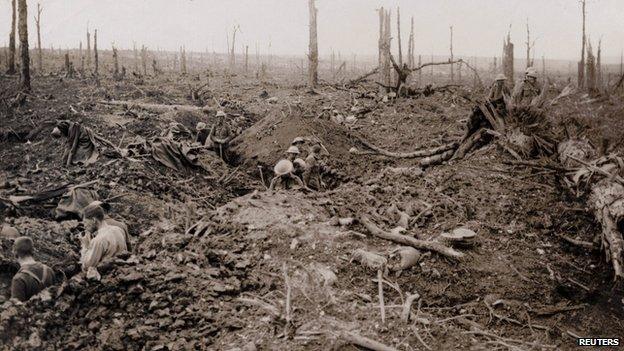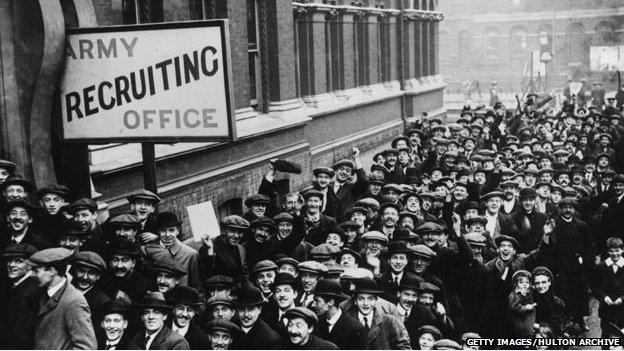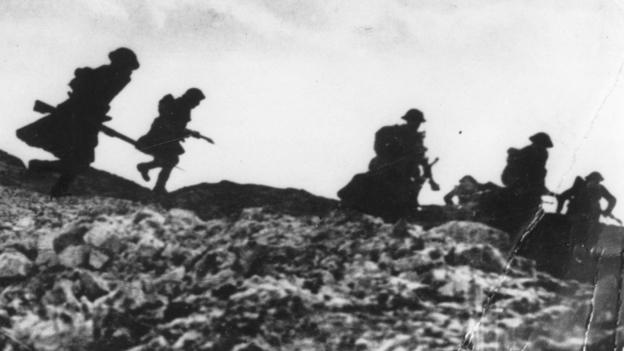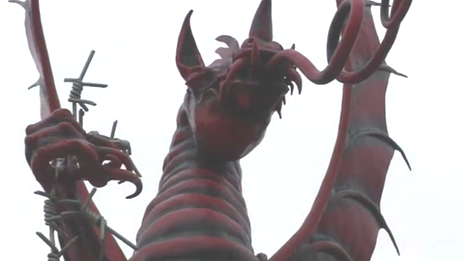WW1: Surviving 'hell on earth' at Mametz Wood
- Published

About 4,000 men from the 38th (Welsh) Division were killed or injured at Mametz Wood in 1916
"Hell on earth" was how Albert Evans from Briton Ferry summed up his experiences of the First World War in a BBC interview in the 1970s.
He was 19 when he fought in the now infamous battle at Mametz Wood in northern France in 1916.
One of 237,000 men and boys from Wales to serve in the Great War, he survived. Tens of thousands didn't.
In one of the bloodiest battles of the Somme, 4,000 men from the 38th (Welsh) Division were killed or injured at Mametz Wood.
In BBC archive footage Albert Evans recalls how the line of men which advanced towards the wood "withered away" before his eyes.
"The machine guns of the Germans were just spraying fire over the open site," he said. "You couldn't get near the wood."
Author Peter Robinson from Burry Port, who has researched the division, described the first attack as a "disaster" as the men, outflanked by two machine guns, attempted to advance up a slope while evading gun fire.
"Quite frankly it was a no hope situation," he said.
Following that first abortive attempt to capture the heavily fortified wood, Major General Ivor Philipps, the officer commanding the 38th Division, was relieved of his role.
Archive recordings of Welsh soldiers who served in World War One
Control was instead given to Major General Herbert Watts and a second attempt was made.
"The wood was very thick and dense, the soldiers became very disorientated, but they pushed through and forced the Germans out," said Robinson.
The enemy may have been cleared but the 38th Division paid a heavy price.
Lord Thomas of Gresford recently highlighted the role of the Division in the House of Lords, describing the loss of men in the battle as a "huge tragedy for the whole of Wales".
He said 1,000 men from the Rhondda Regiment went in to battle that day, but only 135 men answered the roll call the following day.
"The rest were either missing or wounded or most likely dead," he said.
The loss of life and casualties was so severe the 38th Division was out of action for almost a year.
In July 1917 it regrouped for the battle of Pilckem Ridge.

As well as the Western Front, Welshmen saw action at Mesopotamia, Palestine, Gallipoli and beyond
"Pilckem Ridge was the start of what we now know as Passchendaele," said Mr Robinson. "It was another disaster."
The campaign on the Western Front was fought over the control of the ridges south and east of the Belgian city of Ypres in Flanders.
But as rain poured relentlessly, the battlefield turned into a shattered landscape of mud.
"It's said it took six men to carry a stretcher and they were knee-deep in the mud," said Mr Robinson. "It was impossible."
Away from the Western Front, Welsh recruits also saw action in places like Mesopotamia, Palestine and Gallipoli.
Many also joined other divisions and fought across the battlefields of World War One.
Between 1914 and 1918, 237,000 men and boys from Wales served - more than a fifth of the male population at the time.
An estimated 38,000 lost their lives.
Fourteen were awarded the highest military honour, the Victoria Cross, but almost as many were shot for cowardice or desertion - a notion rejected by Lord Thomas.
"They didn't recognise the stress disorders that we do today," he said.
"I don't think it was cowardice at all. These people were put in an impossible position, a terror that drove people to desert their post."
- Published6 August 2014

- Published4 August 2014

- Published4 August 2014

- Published24 June 2014

- Published12 July 2013
